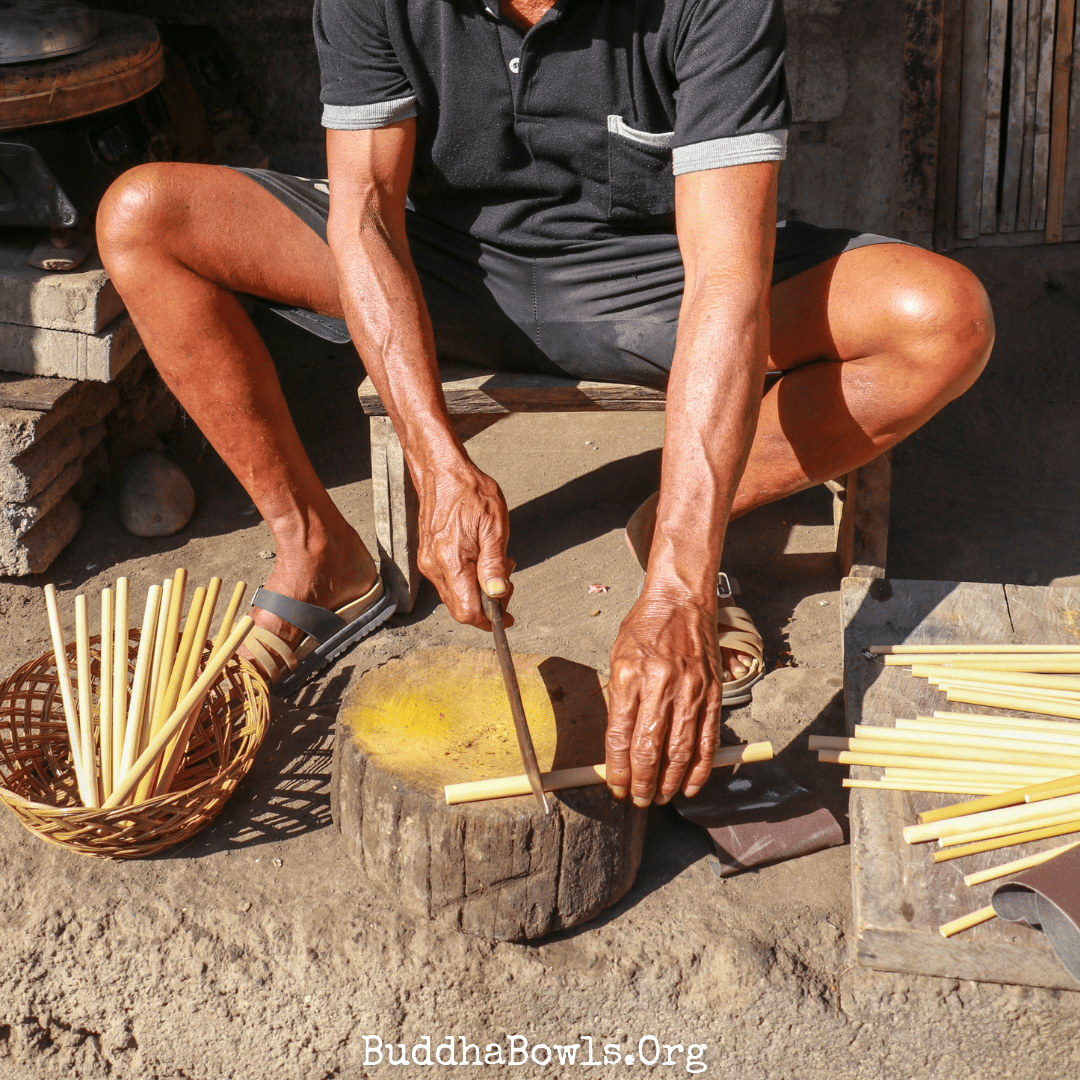Artisan Spotlight Series
Illuminating the path of craftsmanship, our Artisan Spotlight Series celebrates the mindful creators behind our coconut bowls.
Embark on a journey of discovery through our Artisan Spotlight Series, where we illuminate the path of craftsmanship and mindful creation. Each month, we delve deep into the lives and practices of the skilled artisans behind our coconut bowls. These masters of their craft share their stories of dedication, their connection to nature, and the meditative process of transforming coconut shells into works of functional art. Through intimate interviews, stunning photo essays, and behind-the-scenes videos, you’ll witness the alchemy of turning nature’s gifts into vessels of sustainability. Learn how these artisans infuse each bowl with intention, creating not just a product, but a conduit for mindful living. Their hands, weathered by years of work, shape each bowl with the wisdom of generations, honoring the coconut’s journey from palm to table. Join us in celebrating these unsung heroes of sustainability, whose work bridges the gap between ancient traditions and modern eco-consciousness.
Meet our talented coconut bowl artisans!
Spotlight on Artisans Who Create Coconut Bowls
In a world increasingly focused on sustainability and eco-conscious living, coconut bowls have emerged as a shining example of how creativity and environmental responsibility can go hand in hand. These beautiful, handcrafted bowls are not just functional kitchenware; they are a testament to the artistry and dedication of the artisans who make them. Today, we’re shining a spotlight on the talented individuals behind these eco-friendly treasures and exploring the stories and processes that bring coconut bowls to life.
A Craft Rooted in Tradition and Sustainability
Coconut bowls are made from discarded coconut shells, which would otherwise be treated as waste. In many tropical countries, coconuts are harvested for their water, oil, and flesh, leaving the shells as byproducts. Instead of letting these shells go to waste, artisans have found a way to transform them into something both beautiful and practical.
By repurposing coconut shells, these artisans not only reduce waste but also create sustainable livelihoods for themselves and their communities. This craft is often passed down through generations, blending traditional techniques with modern aesthetics to meet the growing demand for eco-friendly products worldwide.
The Art of Crafting Coconut Bowls
Creating a coconut bowl is no simple task—it’s a labor of love that requires skill, patience, and attention to detail. The process usually begins with selecting high-quality coconut shells. These shells are cleaned thoroughly to remove any remaining coconut fibers and then sanded down to create a smooth surface.
Once the shell is prepped, artisans shape it into a bowl using hand tools or simple machinery. Each bowl is unique in size, shape, and texture, reflecting the natural variations of the coconut shell itself. To enhance durability and aesthetic appeal, many artisans polish the bowls with natural oils, giving them a glossy finish that highlights their rich, earthy tones.
Some artisans take their craft a step further by adding intricate carvings or hand-painted designs to their coconut bowls. These embellishments turn the bowls into true works of art, making them perfect for both everyday use and decorative purposes.
Supporting Artisan Communities
Behind every coconut bowl is a story of resilience and creativity. Many artisans who create these bowls live in rural areas where job opportunities can be limited. By purchasing coconut bowls, consumers directly support these artisans and their families, helping to sustain their livelihoods while preserving traditional craftsmanship.
In some cases, artisan collectives or fair-trade organizations work with these creators to ensure they receive fair wages and safe working conditions. These initiatives empower artisans, particularly women, to achieve financial independence and invest in their communities.
The Artisans Behind Coconut Bowls: Stories of Craftsmanship and Culture
In a world increasingly conscious of sustainability, coconut bowls have emerged as a symbol of eco-friendly living and artistic expression. These handcrafted treasures are not just functional kitchenware; they carry the soul of the artisans who pour their passion and creativity into every piece. Let’s take a journey across the globe to meet some of the talented individuals behind these beautiful creations, learning about their stories, traditions, and the unique artistry that defines their work.
Laksmi
Location: Bali, Indonesia
About: Bali is renowned for its vibrant culture and skilled artisans, and Laksmi is no exception. Growing up in a small village surrounded by lush coconut groves, she learned the art of crafting coconut bowls from her grandmother. For Laksmi, each bowl tells a story of her heritage. She carefully selects discarded coconut shells, sands them down, and polishes them to perfection.
“My grandmother always said that nothing in nature should go to waste,” Laksmi shares with a warm smile. “Every coconut shell has its own character, and it’s my job to bring out its beauty.”
Her designs often feature intricate carvings inspired by Balinese motifs, such as lotus flowers and traditional patterns. Laksmi’s work not only provides her with a livelihood but also keeps her family’s traditions alive.
Manoj
Location: Kerala, India
About: In the southern state of Kerala, known as the “Land of Coconuts,” Manoj has been turning coconut shells into works of art for over two decades. His journey began as a young boy helping his father in their small workshop. Today, Manoj is a master craftsman whose bowls are admired for their smooth finishes and natural charm.
“I see each coconut shell as a gift from nature,” Manoj explains. “My goal is to create something useful and beautiful while respecting the environment.”
Manoj’s bowls are often paired with wooden utensils, making them a favorite among eco-conscious customers. His work has brought him recognition across India and beyond, allowing him to support his family and provide training to aspiring artisans in his community.
Nguyen Thi Hoa
Location: Hanoi, Vietnam
About: In Vietnam, Nguyen Thi Hoa has gained a reputation for her vibrant, lacquered coconut bowls. Using techniques passed down through generations, she transforms plain coconut shells into colorful pieces of art. Hoa’s bowls are often adorned with hand-painted designs featuring nature scenes, animals, or geometric patterns.
“I love experimenting with colors and textures,” Hoa says. “Each bowl is like a canvas where I can express my creativity.”
Hoa’s workshop employs several women from her village, providing them with stable income and opportunities to learn new skills. For Hoa, crafting coconut bowls is not just about art—it’s about empowering others and preserving traditional Vietnamese craftsmanship.
Putu
Location: Lombok, Indonesia
About: On the Indonesian island of Lombok, Putu has made a name for himself as an artisan who specializes in minimalist designs. Unlike other craftsmen who carve or paint their bowls, Putu focuses on simplicity, allowing the natural grain of the coconut shell to shine through.
“I believe there is beauty in simplicity,” Putu says thoughtfully. “The natural imperfections of the coconut make each bowl unique.”
Putu’s work is inspired by the island’s serene landscapes and his deep connection to nature. His bowls are popular among those who appreciate understated elegance and sustainable living.
Amara
Location: Accra, Ghana
About: In Ghana, Amara is one of the few artisans creating coconut bowls in West Africa. She discovered her passion while searching for ways to repurpose waste materials in her community. Amara’s bowls are often embellished with bold African patterns or beads made from recycled glass.
“For me, it’s about giving new life to something that would otherwise be thrown away,” Amara explains. “Each bowl is a celebration of our culture and our commitment to sustainability.”
Amara’s work has gained attention at local markets and international fairs, helping her raise awareness about environmental issues while showcasing Ghanaian artistry.
Luis
Location: Oaxaca, Mexico
About: In the heart of Oaxaca, Mexico, Luis combines his love for nature and art to create coconut bowls with a distinctive flair. Drawing inspiration from indigenous Zapotec designs, he incorporates vibrant colors and patterns into his work.
“Every bowl I make is a tribute to my roots,” Luis says proudly. “I want people to feel the spirit of Oaxaca when they use my creations.”
Luis collaborates with local farmers to source coconut shells and promotes fair trade practices. His efforts have not only boosted his community’s economy but also highlighted the rich cultural heritage of Oaxaca.
Why Coconut Bowls Matter
Beyond their aesthetic appeal, coconut bowls represent a shift toward more sustainable living. By repurposing discarded coconut shells that would otherwise be burned or discarded as waste, these artisans are helping reduce environmental impact while preserving traditional craftsmanship. Each bowl carries the unique touch of its maker—a reminder of the human connection behind everyday objects.
When you purchase a handcrafted coconut bowl, you’re not just buying a product; you’re supporting talented artisans like Laksmi, Manoj, Hoa, Putu, Amara, and Luis. You’re investing in their stories, their communities, and their dreams for a better future.
So next time you enjoy your smoothie or salad from a coconut bowl, take a moment to appreciate the artistry and culture that went into creating it. These humble yet extraordinary pieces remind us that beauty can be found in simplicity—and that even the smallest choices can make a big difference.
Why Coconut Bowls Are a Win-Win
For consumers, coconut bowls offer a way to embrace sustainable living without compromising on style or functionality. They are lightweight yet sturdy, making them perfect for serving everything from smoothie bowls to salads. Plus, their natural aesthetic adds a touch of rustic charm to any table setting.
But the benefits go beyond practicality and beauty. By choosing coconut bowls over plastic or ceramic alternatives, you’re helping to reduce environmental waste and support ethical craftsmanship. It’s a small but meaningful step toward a more sustainable future.
How to Care for Your Coconut Bowl
To extend the life of your coconut bowl, it’s important to care for it properly. Avoid exposing it to extreme heat or placing it in the dishwasher, as this can cause cracking or warping. Instead, wash your bowl gently with warm water and mild soap, then dry it thoroughly. Reapplying natural oil periodically can help maintain its luster and durability.
A Movement Worth Celebrating
The rise of coconut bowls is more than just a trend—it’s part of a larger movement toward mindful consumption and appreciation for handmade goods. By celebrating the artisans who create these bowls, we honor their craftsmanship and commitment to sustainability.
So the next time you enjoy your breakfast from a coconut bowl, take a moment to think about the hands that made it. Behind every curve and polish is an artisan who has poured their heart into turning nature’s leftovers into something extraordinary. And that’s something worth celebrating!

